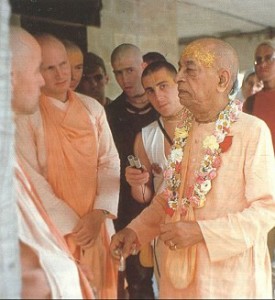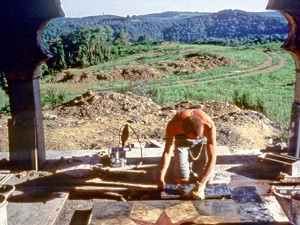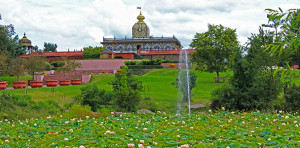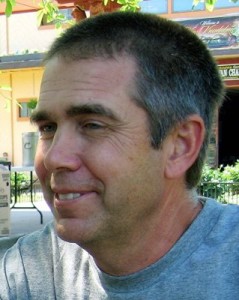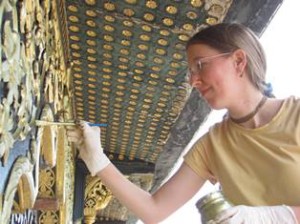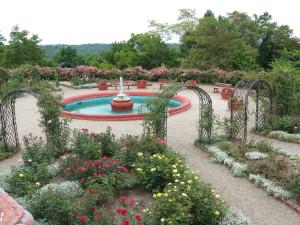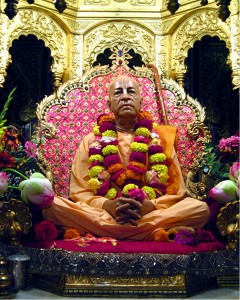Restoration Work Underway at Palace of Gold in New Vrindaban
Restoration Work Underway at Palace of Gold in New Vrindaban.
by Madhava Smullen
Today, as they did four decades ago, devotees at ISKCON New Vrindaban are embarking on a labor of love.
They’re undertaking the restoration of the Palace of Gold, home to Srila Prabhupada, ISKCON’s Founder-Acarya, to continue spreading his glories to the world.
Devotees began building the Palace with their own hands back in 1973 as a simple residence for Srila Prabhupada, who enjoyed the peace and spiritual atmosphere of New Vrindaban during his visits.
But as construction progressed, their plans became more and more ambitious. Srila Prabhupada was frequently expressing his desire to retire from the active management of his growing movement to focus on his translation work, and he often cited New Vrindaban as the place to do this. So his disciples wanted to create a home truly befitting him there.
Working with no pay and very little experience, they trained themselves in traditional artisanal skills. Designer Bhagavatananda said he didn’t have the slightest idea whether or not he was breaking architectural rules – he and the other devotees just worked from inspiration. The results, straight from their hearts, were stunning, as workers spent hours painstakingly handcrafting each piece.
Throughout, Srila Prabhupada’s love and encouragement kept them going.
“Regarding New Vrindaban I was very happy when I was there,” he wrote to Kirtanananda on October 5th, 1974. “Not only myself but all devotees and GBC members all enjoyed the atmosphere of New Vrindaban, especially the cow protection scheme. May Krishna give more facilities to advance the cause of New Vrindaban, and I am expecting very soon to go there and live in my proposed palace at least for some time.”
But Srila Prabhupada would never stay at his Palace while he was physically alive. He passed away in 1977 before it was completed. Yet this only fueled his disciples’ determination to construct a singularly beautiful monument to their beloved guru, his astounding achievements and the gifts he had given the world.
After all, the guru never dies but is always present in his instructions – so Srila Prabhupada still resides in his Palace in spirit as long as he is remembered and honored there by his followers.
In 1979, Srila Prabhupada’s Palace of Gold officially opened its gates to the public. Thousands of tourists, as well as one thousand devotees from all over the world, flooded in to see Prabhupada at his New Vrindaban home.
One of them was Gopisa Das, who arrived at New Vrindaban to help finish the Palace’s wrought iron gates and cook for the festival. Now, thirty-four years later, he is ISKCON New Vrindaban’s Director of Facilities and also the acting project manager for the Palace restoration.
“I was absolutely overwhelmed when I first saw the Palace,” he says. “It was so beautiful. But what was most exciting to me was the spirit of cooperation, to see so many devotees working together for the pleasure of Srila Prabhupada.”
With its gold-leafed domes rising above the emerald West Virginia hills, Prabhupada’s Palace is an impressive feat of architecture. Visitors can walk through the award-winning Palace Rose Garden and up the steps to the Palace, pausing before they enter to marvel at the picturesque views from one of the four corner chattras, or domed lookouts.
Inside, sunlight pours in through thirty-one stained glass windows, made from over 1,500 pieces. The walls and floor are made from fifty-two kinds of marble, each piece cut, polished and set with loving care.
And the rooms, originally designed for Prabhupada’s personal use, include a bedroom, a bathroom, and a study where a life-sized replica of Prabhupada leans over his desk, translating his books. For devotees and visitors, this is a place where they can sit, spend time with him and feel his presence as he executes his most cherished service to his own spiritual master.
Finally, in the temple room, a murti form of Srila Prabhupada sits on an ornate gold-leaf throne, beneath a domed ceiling made from over 4,000 pieces of crystal.
With all this, it’s no surprise that the Palace has long been one of West Virginia’s biggest tourist attractions, dubbed “The Taj Mahal of the West” by the New York Times and drawing up to 60,000 visitors a year at its peak in the 1980s.
Over the years, that number has declined. But the Palace managers, led by Tripada Vibhuti Das, continue to work closely with the Marshall County Tourist Board, and still receive twenty to twenty-five thousand tourists annually. Media coverage still abounds, with the July 2012 edition of CNN Travel selecting The Palace of Gold as one of the eight religious wonders to see in the United States. And guests on all the Palace tours learn about Srila Prabhupada and his amazing efforts in bringing Krishna consciousness to the Western World.
“Through the tour people really appreciate Srila Prabhupada, as well as the love that went into making the Palace for him,” Gopisa says.
Of course, for devotees, Prabhupada’s Palace is much more than a tourist attraction. It is a holy place of pilgrimage, one of only three samadhis, or official memorials, to Srila Prabhupada in the world, along with his Samadhi Mandir in Vrindavan, India, and Pushpa Samadhi in Mayapur.
“And of course, being the only official memorial dedicated to Srila Prabhupada here in the West,” Gopisa says, “It does provide a focal point for devotees to offer their respects and see him in this very beautiful rural setting, which he very much appreciated.”
A dedicated crew of devotees still steadily worship Srila Prabhupada at his Palace, cooking offerings at Sri-Sri RadhaVrindabanchandra’s temple and taking them up to him. Some visit for Mangal arati early in the morning, or go to hear senior devotees speak about Srila Prabhupada in the early days of ISKCON. And of course, Prabhupada’s appearance day and disappearance day are observed at the Palace.
But still, the Palace has not been celebrated amongst ISKCON devotees as much as it deserves in recent years, partly due to the fact that New Vrindaban temporarily parted ways with ISKCON from 1988 to 1998. At the time, many devotees felt as if the heart of Srila Prabhupada’s society had been ripped out, and in some ways New Vrindaban and ISKCON North America have never been quite the same since.
Another reason for the current lower awareness of Prabhupada’s Palace is the visible disrepair as a result of novice construction methods, signs of which began to show as early as the late 1980s. Today, chunks are missing from the outer wall, wrought iron pieces are rusting, the chattras and other cast concrete pieces are crumbling, and the granite on the steps leading up to the Palace is shifting from faulty concrete underneath.
Over the years, in the same loving spirit that infused the original builders, devotees like Tripada Vibhuti have patched up and painted what they could.
But lack of funds prevented a full restoration, until mid 2009, when an inspired Ramesvara Das joined forces with GBC Malati Dasi and other senior disciples to form the Palace Restoration Committee.
The group researched several architectural firms and selected Kayafas Architects of Wheeling, West Virginia, a local firm with an excellent reputation for historic preservation, to assess what needed to be repaired.
Fortunately, engineers concluded that the core structure of the Palace was sturdy and showed no indications of stresses or cracking.
Meanwhile, plans were put in place to repair the outer wall, the portico railing, the steps and the chattras as quickly as funding allows — the project is expected to cost around $1 million.
Some of these elements will be completed by the 50th anniversary of ISKCON’s founding in 2016, while others will be ready by the 50th anniversary of New Vrindaban in 2018.
Although the project will employ professional consultants, much of the actual construction work will once again be done by devotees, in keeping with the legacy of the Palace.
“We’re older and smarter now,” Gopisa says, grinning. “And we have more training and information. When the Palace was first built, there was a real push to get it done as quickly as possible, and shortcuts were taken. We won’t make those same mistakes again. The materials we use will be tested to make sure that they’re of the proper standard and quality before they’re installed.”
Beyond 2018 is a larger, $5 to $7 million plan for the Palace’s expansion, which will take at least ten years to complete.
The final vision will see visitors pull into a larger parking lot, and first enter a welcome center and gift shop. They’ll then be guided through a museum about Srila Prabhupada where they will see different artifacts connected to the ISKCON founder.
Next, they’ll view a multimedia presentation on Srila Prabhupada’s life, and on the history of his Palace of Gold. Finally, they’ll take a tour through the Palace itself, culminating in a visit with Srila Prabhupada’s murti in his temple room.
With Gopisa Das already fully occupied as facilities manager, and Tripada Das tasked with the day-to-day running of the Palace, ISKCON New Vrindaban is currently searching for a dedicated project manager to realize this grand vision.
“We’re hoping that there are devotee professionals out there who would consider taking this up as their life’s work,” Gopisa says. “The applicant would require a background in many different fields of construction and would have to have the experience necessary to oversee a large multi-million dollar, multi-year restoration project such as this.”
Meanwhile other devotees can help by donating, or by visiting Srila Prabhupada at his Palace and doing a few days or weeks of service there.
This support is key, for many believe that restoring Srila Prabhupada’s Palace will symbolically show that New Vrindaban is once again rightly situated, and will raise morale throughout ISKCON North America.
A restored Palace, of course, will also create new interest amongst the public in Srila Prabhupada’s unique contribution.
“Without Srila Prabhupada, we would not have Krishna consciousness in the Western World,” Gopisa says. “His significance and contribution cannot be overstated. So having this focal point in the West where people can come and learn about him is very important.”
“In the future, we hope that the Palace will be restored beyond its former glory,” Gopisa concludes, “And that many thousands more will come and truly appreciate Srila Prabhupada, and the devotion that went into building this Palace for him.”
To donate towards the restoration project, please visit palaceofgold.com.
To apply for the position of Palace Project Manager, please contact Jaya Krishna Das at jaya.krsna.sns@gmail.com.
